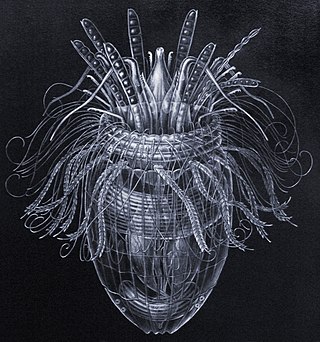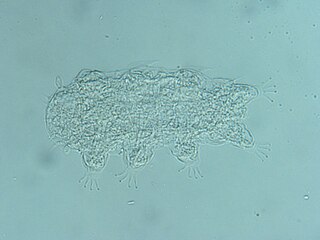
Pliciloricus enigmaticus is a marine Loriciferan species of genus Pliciloricus first described by Higgins & Kristensen 1986.

Pliciloricus is a genus of marine organisms Pliciloricidae family, the phylum Loricifera described by Higgins & Kristensen, 1986.

Pliciloricidae are a family of marine organisms in the phylum Loricifera. It contains 23 species in 4 genera.
Rugiloricus is a genus of marine organisms of the phylum Loricifera and the family Pliciloricidae, described by Higgins & Kristensen in 1986.
Rugiloricus cauliculus is a species of marine animal of the phylum Loricifera and the family Pliciloricidae. The species was described by Higgins & Kristensen in 1986, however other sources such as OBIS indicate that discovery of the species occurred on 19 November 1983.
Pliciloricus dubius is a marine Loriciferan species of genus Pliciloricus described by Higgins & Kristensen 1986.
Robert Price Higgins was an American systematic invertebrate zoologist and ecologist, who specialized in the unusual taxa of kinorhynchs and tardigrades.

Arthrotardigrada are an order of tardigrades, first described by Marcus in 1927.
Batillipes is genus of tardigrades, the only genus in the family Batillipedidae. It was first described by Ferdinand Richters in 1909.

The Halechiniscidae are a family of tardigrades. The family was named and first described by Gustav Thulin in 1928.

Renaudarctus is a genus of tardigrades in the family Renaudarctidae. The genus was first described by Reinhardt Kristensen and Robert P. Higgins in 1984, and named after biologist Jeanne Renaud-Mornant.
Renaudarctidae are a family of tardigrades. It was first described in 1984 by Reinhardt Kristensen and Robert P. Higgins, and named after biologist Jeanne Renaud-Mornant.
Novechiniscus armadilloides is a species of terrestrial tardigrade. It is the only species of the genus Novechiniscus, which belongs to the family Echiniscidae. The species is endemic to the United States in the state of Utah.
Styraconyx is a genus of tardigrades in the family Styraconyxidae. The genus was named and first described by Gustav Thulin in 1942.
Clavarctus falculus is a species of tardigrades. It is the only species in the genus Clavarctus, part of the family Halechiniscidae. The species has been found in deep sea in the Mozambique Channel.
Proclavarctus fragilis is a species of tardigrades. It is the only species in the genus Proclavarctus, part of the family Halechiniscidae. The species has been found in deep sea in the Mozambique Channel and the Bay of Biscay.
Bathyechiniscus tetronyx is a species of tardigrades. It is the only species of the genus Bathyechiniscus, which belongs to the family Styraconyxidae. The species and genus were named by Gotthold Steiner in 1926, for the presence of four different exposed points or hooks on each claw. The species has been found in the Davis Sea, on the eastern coast of Antarctica.
Exoclavarctus is a genus of tardigrades in the family Halechiniscidae. Its only species is Exoclavarctus dineti. The species has been found in the deep sea in the Bay of Biscay.
Moebjergarctus manganis is a species of tardigrades. It is in the genus Moebjergarctus, part of the family Halechiniscidae. The species has been found in the southeastern part of the Pacific Ocean. They were first named and described by Christian Bussau in 1992.
Opydorscus fonsecae is a species of tardigrades. It is the only species in the genus Opydorscus, part of the family Halechiniscidae and the subfamily Orzeliscinae. The species has been found on the Brazilian coast of the South Atlantic Ocean. The genus and the species were named by Jeanne Renaud-Mornant in 1983.




